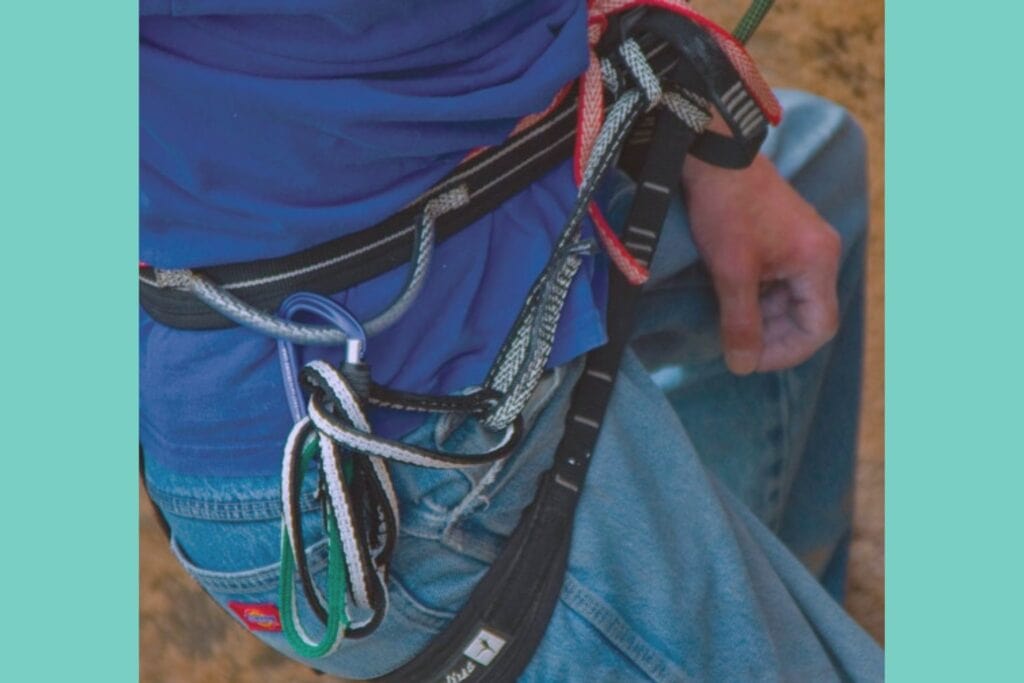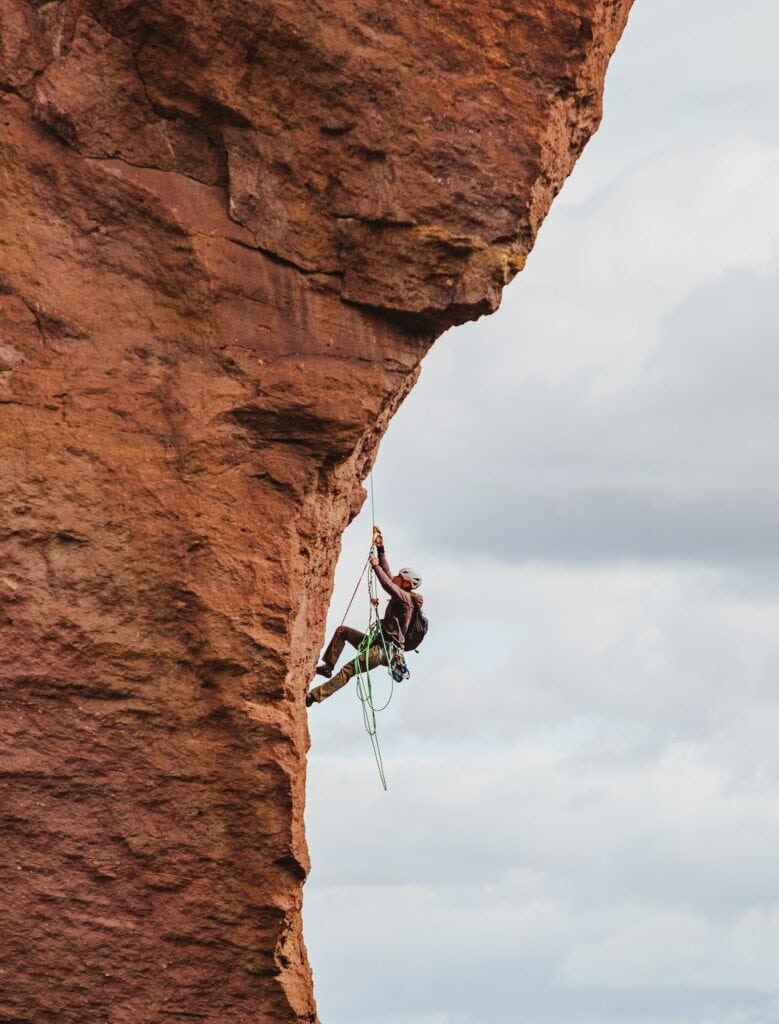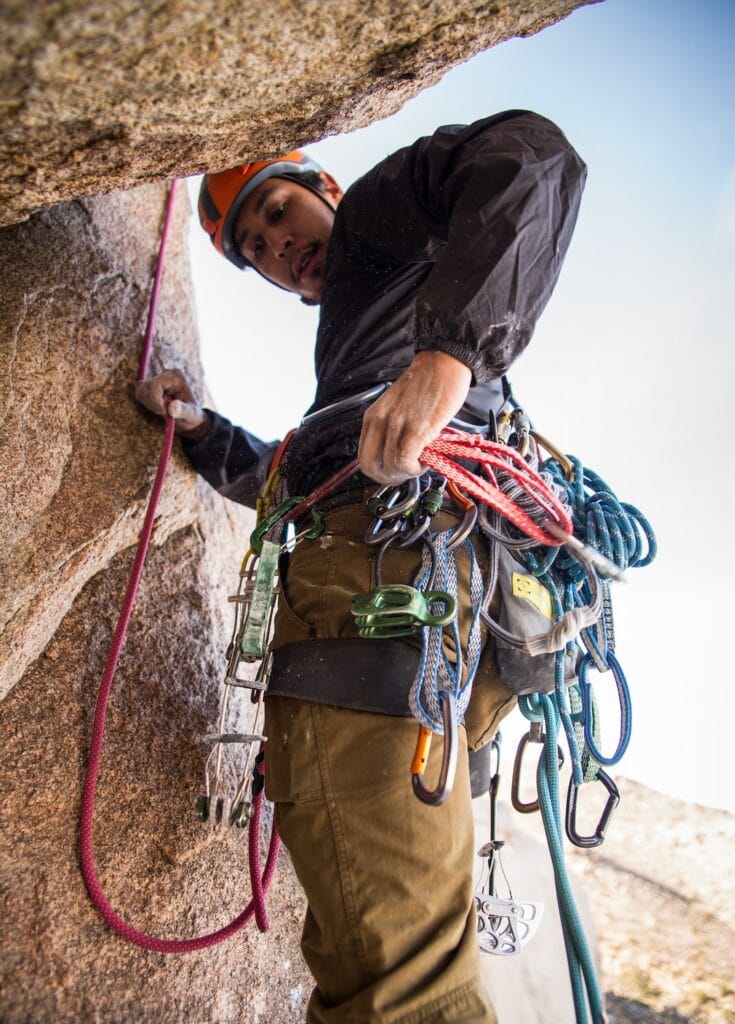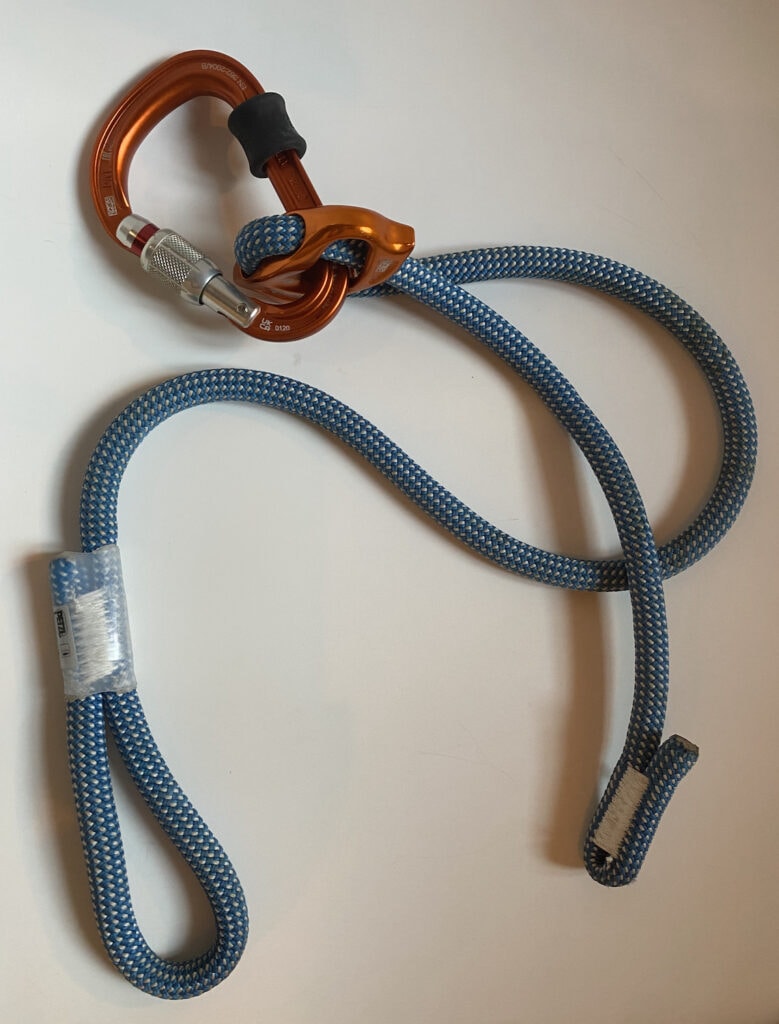Personal Anchor System for Climbing: What to Pick (2024 guide)

Published on: 07/10/2023
One of the most important pieces of equipment for a rock climber is a personal anchor system. Personal anchor systems function as important lifelines that connect the climber to something solid like most anchors.
When it comes to selecting a personal anchor system, there is no perfect product. And there is no perfect way to whether yourself. It all depends on your preferences, experience, and climbing scenario. The reality is that you will be faced with tons of options, from specialty-built tools to improvised tethers with linked quickdraws.
Keep reading to learn about personal anchor systems and how you can incorporate them into your climbing.
What’s a Personal Anchor System?
A personal anchor system (PAS), sometimes called a lanyard or tether, is a piece of climbing equipment that directly connects the climber to a climbing anchor system.
A PAS is a critical climbing tool because it allows you to safely transfer your body weight off the climbing rope and onto a climbing anchor or belay station. This allows you to free up the climbing rope and use it to continue climbing upwards, like on multi-pitch routes, or to transition downwards on sport climbs.
Below, I will talk more about the scenarios where you can deploy tethers. But first, let’s talk about the anatomy of a personal anchor system.

Components of a Personal Anchor System
Every personal anchor system is a little bit different. Therefore, the components that comprise the one you eventually choose to use may be different from what you see other climbers using. However, regardless of the PAS, there are some critical components you’ll see on practically every PAS.
- An attachment point to the harness: most personal anchor systems connect to either the two tie-in points or the belay loop of your harness with a girth hitch (but sometimes a basket hitch).
- Knots, sewn loops, or an additional device for adjusting the length: depending on the model, there will be different ways to make the PAS adjustable. For example, knots in a nylon sling or loops in a daisy chain.
- A locking carabiner for connecting the PAS: at the end of every personal anchor system, most climbers will use a locking carabiner for attaching their PAS to belay stations. However, some climbers may prefer to attach a non-locking carabiner.

Scenarios Where You Use a Personal Anchor System
Personal anchor systems are versatile tools that you can apply in various rock climbing scenarios. Below I will talk about some of the most common uses for your PAS
Rappelling in Multi-Pitch Climbing
After you have completed a climb, it becomes time to descend. In many scenarios, rappelling is chosen form of descent. You can use a PAS to extend your rappel device and mitigate risk as you prepare for rigging your rappel.
For example, in a multi-pitch climbing scenario where you plan to descend on the fixed anchors you just used for climbing the last pitch, rigging a rappel involves transferring the load, i.e., your body weight, from the climbing rope onto the fixed anchor. Then, you can untie your climbing knots and use the rope to rig the rappel.
Additionally, multiple rappels may be required to reach the ground in multi-pitch climbing. In that scenario, you can use your personal anchor system to connect directly to each rappel anchor as you descend downwards.
That way, you are always actively connected to one of two things– the rappel system threaded through the previous rappel anchor or the next rappel anchor via your PAS.

Building Anchors at the Top of a Pitch
When you reach the top of a pitch in single-pitch terrain, you can use a PAS to anchor yourself in place while you build an anchor. This is convenient because it gives your belayer the opportunity to relax while you build the anchor.
However, to be clear, your belayer should never take you off belay. Not unless you have clearly communicated that you plan to descend without them via rappelling.
In the sport climbing context, using a PAS is as simple as clipping into one of the bolts of the fixed anchor (and backing it up). Then, because you are in direct, you can safely ask your belayer for slack as you build your anchor and prepare to lower back down.
Similarly, in my guide work, I frequently use a PAS to add security when I am on top of the cliff, especially in terrain where I can access the top without having to lead climb.
In this scenario, as I approach the fixed anchor where I want to build a top rope anchor, I clip in with PAS to mitigate the risk of falling off the edge. Then I build my anchor, rig an extended rappel on my tether, and descend.
Cleaning Anchors in the Sport Climbing Context
In sport climbing, it’s common to build anchors for top roping or swapping lead burns. This is especially true for fixed anchor systems that do not have perma-draws for you to drop your rope into.
After building an anchor, you will eventually have to clean to retrieve your gear and move on to the next climb. In this scenario, you can use a PAS to connect yourself directly to the fixed anchor system. Then, you can ask your belayer for slack and proceed with the cleaning process.
After you’ve prepared the fixed anchors to be lowered by your belayer and have cleaned the anchor you built, you ask to be lowered.

How to Pick the Best PAS
Picking the best PAS for you will depend on your climbing style and how you intend to use the PAS. Here are some items to consider.
Commercial vs. DIY Personal Anchor Systems
You can buy a purpose-built commercial PAS or make your own.
The advantage of buying a purpose-built PAS is that you have a dedicated tool for any and all situations where you need to anchor in. Beginner climbers may prefer a commercial PAS, like the Metolius anchor chain, because they are easy to use.
However, you can also make your own PAS. You can build a PAS with nylon or Dyneema sewn slings. The advantage of this is that the sling can be used for other purposes while you’re not using it as a PAS, like for building anchors or extending trad gear placements.
Criteria to Consider for DIY Personal Anchor Systems
If you like the idea of building a PAS with sewn sling instead of using a commercially manufactured tool like daisy chains or the Metolius personal anchor system, consider the following.
Material
For the most part, slings are constructed with nylon or dyneema (also called dynex or spectra, depending on the brand). Each material comes with its own pros and cons. However, if I am honest, I prefer something made with Dyneema.
Nylon
Pros
Cons
Dyneema
Pros
Cons
Length
The length of tethers varies. For example, specialty tethers like the Petzl Connect Adjust or Metolius Personal Anchor System come in at about 38 inches (around 95 centimeters). Then they can be adjusted to shorter lengths to fit your scenario.
On the other hand, sewn loops of nylon or Dyneema are different. For most scenarios, I would recommend a 48-inch (120-centimeter) sewn loop because they are most user-friendly.
However, if you know how to manage the extra material, you can also use a 70-inch (180-centimeter) sling.

Application
In terms of application, the most important thing to consider is if you want a specialty tether to deploy for anchoring yourself. Or if you want something more versatile.
A purpose-built PAS like the Metollius PAS 22, Connect Adjust, or Sterling Chain Reactor is perfect if you prefer to have a specific tool for a specific job.
However, for other climbers, a knotted sling is ideal because they simply clip a locker carabiner into the end of the tether and use it to attach themselves. And if they need, they can use the same sling for other applications.
Safety Considerations
Personal anchor systems are designed to help you climb safer and mitigate certain risks while on the cliff. However, like other climbing gear, they need to be applied correctly.
I want to share four safety considerations regarding employing personal anchor systems in your climbing.
- Always Back Up Your PAS: avoid using your PAS by itself, for example, clipping your PAS into a single bolt. It’s good to incorporate redundancy into your climbing system whenever possible to mitigate the risk of catastrophic failure.
- Avoid Shock Loading a PAS: personal anchor systems are not designed to catch falls. So whether you are using a daisy chain, slings, or a Metolius PAS, always avoid falling onto your PAS.
- Always Follow the Manufacturer’s Guidelines for Usage: every PAS is designed to be used within specific manufacturer parameters. Avoid straying outside of those parameters and using your equipment incorrectly.
- Don’t Always Keep Your Pass Rigged on Your Harness: your anchor chain, Metolius PAS, or nylon sling with a knot should not be permanently girth hitched onto your harness. Deploy it when you need it, and remove it when you don’t
Recommended Personal Anchors
Some climbers prefer to make their own DIY personal anchor system for climbing. Others may prefer to deploy a purpose-built PAS. So for the folks out there who prefer to directly attach themselves with a specialized anchoring tool, I recommend the following options.
Petzl Connect Adjust

My personal favorite tethering system, and the one I frequently use in my guiding work, is the Petzl Connect Adjust.
The Connect Adjust is a great PAS because it’s constructed with dynamic material to reduce the peak force transmitted to the user in the event of a fall.
Plus, as the name implies, the Connect Adjust is super adjustable. I can easily manipulate the adjusting device with one hand and have yet to find a scenario where I couldn’t get the perfect length.
Metolius PAS 22
The Metolious PAS 22 is probably one of the most iconic personal anchor systems. I’d argue that when climbers imagine a PAS, they picture the Metolius PAS 22.
That’s because it features a chain-link-style construction that is super convenient to use and adjustable. Each loop is rated to 22 kN, making any of them safe for clipping. Plus, the end loop is made with a different color to easily identify it.
If you wanted to, you could even build an equalized top rope anchor with the PAS 22.
Metolius Dynamic PAS
While we are on the topic of Metolius, it’s worth mentioning the Metolious Dynamic. It features the same exact design as the original PAS 22.
However, the Dynamic version is constructed with a dynamic climbing rope to increase energy absorption and mitigate fall forces in the event of a fall.
Black Diamond Daisy Chain
For big wall and aid climbers, the Black Diamond Dynex Daisy Chain is the chosen tool.
It’s constructed with abrasion-resistant Dynex webbing, which is super lightweight, compact, and strong. The bottom loop is sewn with a half-twist to facilitate clean girth hitching, and the whole thing is made with a tight weave to give it a stiff feel and make it easier to use.
Final Thoughts – Experiment with Different Tethers
I recommend experimenting with different products to find out what type of personal anchor system you prefer. Over time, you will develop your preference and get a more specific idea of which type of tether you prefer and why.
Eventually, you may get to the point where you have multiple tethers you keep around and deploy for different climbing scenarios. For example, for my daily guiding work, I use the Connect Adjust because it’s easy to use and adjustable. However, in my recreational sport climbing, I typically build improvised tethers with quickdraws, and for long alpine routes, I use a sewn sling.
I hope you found this article helpful. Regardless of the PAS you end up choosing, remember to do your double checks

